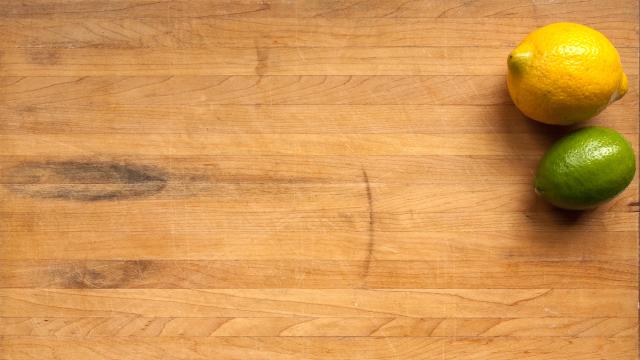Butcher blocks are large, thick pieces of wood ideally suited for meat preparation. Over time they’ve also become a popular choice for kitchen countertops, as their natural look and durability for food preparation make them an aesthetically pleasing and functional choice.
But their upkeep does take a bit of work in terms of cleaning and oil treatments, and getting a stain on your butcher block is the stuff of nightmares — the wood has a tendency to soak up moisture no matter how much you prep it. Unless you apply a thick lacquer, you could soon be dealing with unsightly wine and food stains, or even mildew. But if you already are, there are a couple of ways to clean and refresh your butcher block countertops.
Lemon and salt scrub
It sounds like you are giving your butcher block a spa day, but this method is effective at removing mild stains. Pour some salt on the countertop, then cut a fresh lemon in half and use the cut side to scrub the salt into the stained countertop. (According to HGTV, making a paste with lemon juice and salt and will have the same effect.) After rubbing the lemon and salt into the stained area, leave it to sit overnight. In the morning, wipe the counter down with warm water and a cloth.
Lemon and salt may work for small water stains or small stains from food preparation, but a stronger approach is needed for deeper or darker stains, like wine.
Hydrogen peroxide and white vinegar
Mix one tablespoon of household hydrogen peroxide with one cup of warm water. Using a cloth, cotton ball, or q-tip (depending on the size of your stain) apply the solution to the countertop. Then, dab the stained area with white vinegar. Make sure both solutions cover the stain, and let it sit for two minutes or more. Then, use warm water and a cloth to wipe down the counter.
Bleaching and sanding
If the stains prove to be too stubborn, you can fully refresh your countertops with this in-depth procedure, especially if you have a mildew problem. First, mix a teaspoon of powdered bleach into one cup of hot water, making sure it dissolves into the water. Dip a sponge into the solution and scrub the stained area for a couple of minutes (be sure to wear gloves). Let the bleach solution sit for ten minutes, then rinse the countertop thoroughly.
Sanding down deeper stains works as well — just be sure to treat the wood again after sanding. This Old House advises using:
“a coarse, 60-grit sandpaper or sanding sponge to abrade the discolored wood, but don’t try to get rid of it entirely: Sanding too much in one spot will create a dip. It’s ok to sand across the grain initially, but be sure your final strokes follow the grain.”
Fill cracks with canning wax
This Old House also recommends melting down wax and filling any cracks in your butcher block with the liquid wax. Once the wax is almost dry but still soft, gently scrape away the excess drippings. Afterward, be sure to seal and condition the wood before use.

Leave a Reply
You must be logged in to post a comment.